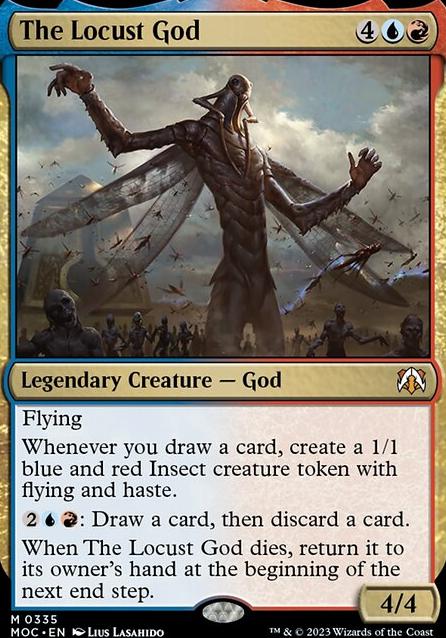The following parameters have been used to determine the strength of the deck. For each, a score of 5 (very good), 4 (good), 3 (mediocre), 2 (bad) or 1 (very bad) has been allocated; when totalized this score represents the power rating of the deck.
- Mana: indicates the availability of mana sources within the deck.
- Ramp: indicates the speed at which mana sources within the deck can be made available.
- Card Advantage: indicates availability of filter- and draw resources represented within the deck.
- Overall speed: indicates the deck’s potential for pace, based on resource availability and mana curve.
- Combo: indicates the measure of combo-orientation of the deck.
- Army: indicates the deck’s creature-army strength.
- Commander: indicates how much the deck is commander-oriented/dependent (less dependency is better).
- Interaction: indicates how much this deck can mess with opponents’ board states and turn-phases.
- Resilience: indicates the measure in which the deck can prevent and take punches.
- Spellpower: indicates the availability and strength of high-impact spells.
Mana: 3
In a deck with this much (cheap) draw, one doesn’t need all that many mana-rocks or similar resources to obtain additional energy as land-drops each turn are just about guaranteed. Nevertheless, it still contains six mana rocks, a card that cheapens Izzet instant- and sorcery casting, one enchantment that grants mana upon creature ETB and two artifacts that produce mana when creatures are sacrificed to them.
Ramp: 1
No ramping options in this deck.
Card Advantage: 5
With lots of additional draw, comes the generation of lots of additional insects. So, it’s in the deck’s interest to include a lot of these options. In total, its CA-arsenal consists of fourteen direct draw cards, twelve soft- and hard wheel cards and two tutors. More than enough to create a whole swarm of flying critters to eat our opponents’ faces.
Overall speed: 3
Some very decent speed can be coaxed out of this beauty, considering the phenomenal amount of CA it contains, along with a good amount of mana resources and a very low average CMC (currently sitting at 2.57). With a bit of luck, it can also mess up the opponents’ speed as an early wheel can really screw up a carefully-selected starting hand.
Combo: 1
Sure, there are a couple of fun ones in here that can grant infinite draw (and thereby infinite generation of insect tokens, which in turn provides infinite ETB triggers) and in some cases infinite colorless mana or even infinite non-combat damage.
Army: 3
Unlike most Izzet decks, this one DOES care about its army of creatures, because it depends on them heavily for victory. Said army will only appear however, once The Locust appears and starts to summon hordes upon hordes of buzzing insects (based on copious amounts of draw). The remainder of creatures are the for support, mostly to generate as much card advantage as possible or to deal damage based on draw or casting.
Commander: 1
There’s not much point to this deck, without its commander being present (since he’s the one generating the insects). Counterspells have been included that are meant specifically to protect him, and there’s also some equipment that can be used towards this end. There are a few alternative win-conditions that can be applied (like ‘wheel’-ing the opposition to death), but these are much harder to achieve.
Interaction: 5
This is actually one of the deck’s major strengths, though this might not be very apparent on a cursory glance. Its biggest contributor in this are nine forced wheel abilities/spells, some of which can be repeated. Then there’s a nice set of five cards that deal non-combat damage and an additional five that handle spell countering. Some other interaction opportunities include a few bounce spells and some forced tapping.
Resilience: 4
Being dependent on one’s commander can be considered a weakness, but for this deck it’s also a strength. It doesn’t take much to have it stay afloat; just The Locust, some draw cards in hand and behold: an army will (re)appear. There’s not much in here to recuperate lost life points though, but it can counter a decent number of harmful spells when forced. It can also recycle cards quite well with four options included that enable this.
Spellpower: 5
The emphasis on this deck is definitely on the non-creature side of things, when it comes to spellcasting. Aside from no fewer than nine wheel spells, there’s also plenty of non-combat damage it can deal across the board through the use of enchantments and sorceries.
Total power score: 31
Though the amount of strategic routes one can take to win with this deck are a bit limited, it is still a fairly balanced whole. Resourcing is good, CA is beyond excellent and it is really quite easy to use; just send that horde of insects into the enemy ranks and watch them devour stuff. The excessive wheeling opportunities contained within the deck can really mess up opposing plans, while it plays exactly to this deck’s strengths. If you enjoy the groans of opponents having to wheel again and again, this will certainly elicit a few guffaws.



